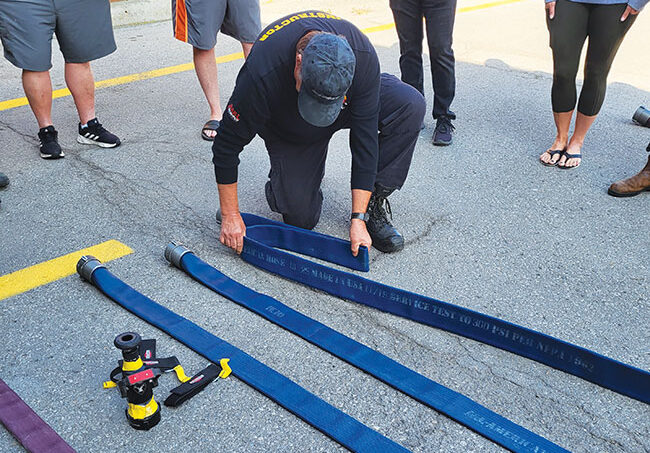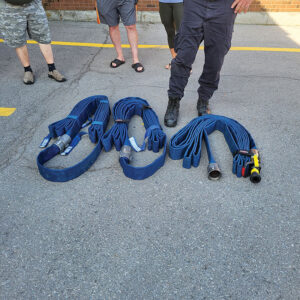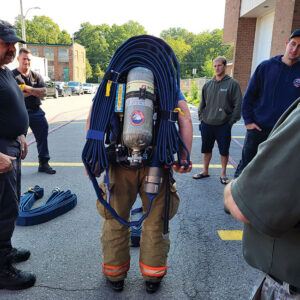
Features
Training
Back to Basics: Hose Packs, Part 1
October 30, 2023
By Mark van der Feyst
 Photo 1: For the Denver Load, once the appropriate mark has been determined, the hose will then be folded in towards the female coupling just like making a horseshoe load.
Photos by Mark van der Feyst
Photo 1: For the Denver Load, once the appropriate mark has been determined, the hose will then be folded in towards the female coupling just like making a horseshoe load.
Photos by Mark van der Feyst On our fire trucks, we will have different configurations for our hose lines with some being pre-connected or others being a dead lay with the expectation of hooking up to a discharge when advancing. There are times when there will be hose arranged in a kit or load to be used for high-rise operations.
Most fire departments will not have high-rises to respond to, so they opt out of having these kinds of kits or loads on their trucks, but they will have buildings that contain standpipe systems. These buildings will be both horizontal such as a big box store or vertical such as a low-rise, mid-rise or a high-rise building. Standpipe systems will require a hose to be brought in to be secured to it, to be charged with water from the system and then used to suppress fire. This is where standpipe hose kits are named after. Instead of being labeled a high-rise kit, they can be called standpipe kits.
Another way to look at this is to call them hose packs as opposed to standpipe kits or high-rise kits. This term has been coined by Captain Brent Brooks from Toronto Fire Services as a way to remove the stigma associated with hose kits being used for “standpipe ops” only or “high-rise ops” only and nothing else. By calling them “hose packs” they take on the multi-purpose role to be used on the fire ground for different situations that may be presented with.
There are three types of hose packs that can be used in the fire service – two are well known with the third not being that popular. The three types are the Denver Load, the New York Load, and the Chicago Load. We are to look at each of the three hose packs in terms of how they are folded or packed, and the benefits and negatives of them.
The first hose pack is the Denver Load. As the name alludes to, this hose load comes out of the Denver Fire Department – more specifically, from and by Assistant Chief Dave McGrail. It was he who designed and created the Denver Load based upon his experiences in dealing with standpipe/high-rise fires. Most hose loads that are configured using this load are going to be 2 ½”, or 65mm in diameter, which assists with making the load. Using a smaller hose diameter is a little more challenging, but still doable. In terms of discussing using the larger or smaller hose diameter for standpipe operations is another discussion.
To start the hose load off right, the firefighter needs to take the female coupling, lay it out on the ground and then place a mark on the hose 32” or 81 cm from the end of the female coupling. If there is no pre-made mark on the hose or the department does not want to mark the hose, a way to determine the demarcation is to use a Velcro hose strap that is 32” or 81 cm in length. The Velcro hose strap can be placed on top of the hose to measure back from the end of the female coupling.
Once this mark has been determined, the hose will then be folded in towards the female coupling just like making a horseshoe load like shown on Photo 1. When bringing in the first fold of the hose, it needs to stop short of the coupling so that the end of the fold is even with the end of the female coupling. This will expose the female coupling out from the hose load to be used later on to finish the hose load.
The hose is continued to be folded in a horseshoe fashion staggering each of the folds so that they are not lining up evenly but staggered so that the hose load will stay tight and slim when completed. Once all the hose has been wrapped around in a horseshoe fashion, the male coupling should be on the opposite side from the female coupling. The hose pack will be split open in the middle to provide a better view of the two parts of the load, with the male and female couplings being joined together. There should be only about one foot of hose hanging out from the load which is the two couplings joined together – the remaining slack of the hose can be folded into the load in different ways.
At this point, the hose load can be strapped with three Velcro hose straps or other types of straps. The hose load needs to be stood up vertically so that the weight of the firefighter can be used to compress the hose load to push out the excess air and to strap the load and make it as tight as possible. Two hose straps go on the male coupling side and the one strap goes on the female side. This will be done for three bundles in total with one of the bundles having a nozzle attached to it.
As you will see in photo 2, the three bundles are placed on the ground side by side with the nozzle pointing toward the fire. From here all three bundles can be connected to each other to form one hose line connected to a water source. One of the advantages of the Denver Load is that it can be carried on the back of the SCBA cylinder as shown in Photo 3, leaving your hands free to carry other equipment.
One of the disadvantages with the Denver Load is the packing of the load — it will require two sets of hands to fold it properly. It also takes repetitive practice to remember how to fold it properly. For those departments that do not use these types of loads often, it can be easily forgotten and become complex to fold.
Another disadvantage is the storage of the load on the truck. Due to its size and horseshoe configuration, it needs to have a compartment large enough to store it standing vertically hanging over a round object or lying flat horizontally.
With the Denver Load, you are choosing it for specific reasons that meet your department’s needs and operations.
Mark van der Feyst has been in the fire service since 1999 and is currently a firefighter with the FGFD. Mark is an international instructor teaching in Canada, U.S. FDIC and India. He is the lead author of Fire Engineering’s Residential Fire Rescue & Tactical Firefighter books. Contact him at Mark@FireStarTraining.com.
Print this page

